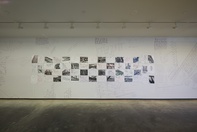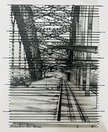Mia Salsjö
Naarm/Melbourne
2023
Displayed 2023 at Museum of Contemporary Art Australia

Mia Salsjö
Born 1977, Naarm/Melbourne
Lives and works Naarm/Melbourne
Mia Salsjö creates multidisciplinary art projects that investigate architectural forms and systems. Salsjö’s projects, grounded in complex code-based systems, encompass drawing, music composition, text, performance, video, and textile-based works. Her works have been included in major international exhibitions including Construction of the Possible, the 13th Havanna Biennial, Havana (2019). Other recent exhibitions include 1000 Year Plan for Gertrude Glasshouse, Gertrude Glasshouse, Melbourne (2022); Modes and Forms (performance), La Trobe Regional Gallery, Morwell, Victoria (2020); The Score, Ian Potter Museum of Art, University of Melbourne, Melbourne (2017); and Mia Salsjö: Prints, Drawings, Multiples, Australasian Cultural Art Exchange Gallery, Melbourne (2019). In 2022, Salsjö was commissioned by Fed Square and the National Gallery of Victoria, Melbourne, to compose A Score for Fed Square (2022), which was performed by musicians from the Melbourne Symphony Orchestra and conducted by Carlo Antonioli. In 2021, she was awarded a City of Melbourne Grant to compose The Quietude (2021), which was performed live in Bunjil Place, Narre Warren, Victoria. Salsjö holds a Master of Fine Art (First Class) from the Victorian College of the Arts, Melbourne, and is currently a resident artist at Gertrude Contemporary, Melbourne.
Image courtesy the artist
Artist text
by Sophie Oxenbridge
Mia Salsjö’s multidisciplinary practice is concerned with self-reflexive processes of translation and scoring. For The National 4, Salsjö has conceived a new installation in response to the iconic structure of the Sydney Harbour Bridge. Comprising drawing, sound, and performance, the work continues the artist’s investigation of the transposition of architectural forms into site-specific musical compositions.
In developing this work, Salsjö has performed a layered process of interpretation, drawing on research mined from public collections as well as state archives. As with all of her site-specific compositions, Salsjö began with architectural studies, which she transcribed into a coded system of numbers, lines, and dots. These algorithmic marks were then expanded into a series of rhizomatic drawings, revealing visual and sonic patterns within the built structure. Exhibited in the galleries, these drawings act as graphic scores for Salsjö’s final musical composition.
In addition to working with architectural plans, Salsjö has engaged in an embodied and spiritual reading of the bridge. The final composition draws on the aesthetic and symbolic resonances of the arc in music as a notation which indicates ‘legato’ – or the joining of one note to the next in a smooth and connected manner – and, in architecture, as a device which bridges time and space. For Salsjö, the form of the arc conveys ideas of triumph, transcendence, and the elevation of the spirit. It is also an essentially life-affirming one, which echoes the rise and fall of one’s breath.
These points of reference overlap with Salsjö’s embodied experience of the bridge. Climbing the bridge on foot, Salsjö came to reflect on the structure as a living organism which absorbs and responds to its environment, reverberating under the weight of the traffic it carries, and eroding from the salt air it breathes in. This interpretation of the bridge was integral to Salsjö’s decision to compose the piece for a brass ensemble, with instruments which reflect the materiality and vibration of the bridge and render the musician’s breath and resignation audible.
As a document which transcribes sound, rhythm, and tempo into visual symbols, the score can be understood as a form of translation itself. In Salsjö’s works, this process is extended to encompass the translation of the imaginative and emotive potential of built architecture, through the musical architecture of composition. By employing the score as both process and outcome in her work, Salsjö’s work defies the traditional understanding of the score as a document which exists primarily to determine the execution of a live performance, complicating the conventional chronology of score–performance–documentation. Utilised instead for its generative potential, the score can be understood in Salsjö’s work as a device that translates as well as ‘trans-acts’ (to borrow a term from Hendrik Folkerts) visual language, the built environment, musical composition, live performance, and documentation. (1) It is through this process of trans-action that Salsjö asks us to reflect on the nature of communication – its potentialities, successes, and failures – itself.
(1) Hendrik Folkerts, ‘Keeping score: Notation, embodiment, and liveness’, documenta 14, 2017, retrieved 1 November 2022, https://www.documenta14.de/en/south/464_keeping_score_notation_embodiment_and_liveness
Artist's acknowledgements
The Bridge (2022) is dedicated to the sixteen workers who lost their lives and to those who were injured or suffered hearing loss during the construction of the Sydney Harbour Bridge.
Original composition by Mia Salsjö
Recording Musicians:
Yoram Levy: Trumpet, Piccolo Trumpet
Callum G'Froerer: Trumpet, Piccolo Trumpet
William Kinmont: Trombone
Kieran Conrau: Trombone
Michael Szabo: Bass Trombone
Rachel Kelly: Tuba
Orchestrated and produced by Mark Buys, Play Pause Record, Melbourne
Musician Management by Briony Buys, Play Pause Record, Melbourne
Recorded by Christian Scallan, The Soft Centre, Melbourne
Field Sound Recording by Oliver Quirk, Museum of Contemporary Art Australia, Sydney
The artist would like to thank Anni Turnbull from the Powerhouse Museum of the Museum of Applied Arts and Sciences, State Library of New South Wales Rare Books and Special Collections, orchestrator Mark Buys, and musician manager Briony Buys.




